SUCCULENTS > KALANCHOE

Elizabeth is a Permaculture Garden Designer, Sustainability Consultant and Professional Writer, working as an advocate for positive change. She graduated from the University of St. Andrews with an MA in English and Philosophy and obtained a Diploma in Applied Permaculture Design from the Permaculture Association.
Reviewed By COLIN SKELLY

Colin is a Horticulturist and Horticultural Consultant with experience in a range of practical and managerial roles across heritage, commercial and public horticulture. He holds the Royal Horticultural Society’s Master of Horticulture award and has a particular interest in horticultural ecology and naturalistic planting for habitat and climate resilience.
Contributions From MICHAEL PERRY

After working at Thompson & Morgan for 18 years, Michael Perry began his online brand ‘Mr Plant Geek’. He now runs his own podcast and has appeared on several TV shows in the UK, including This Morning, The One Show and Steph’s Packed Lunch. Michael was listed in the '20 Most Influential Horticulturists’ by The Sunday Times in 2015.
IN THIS GUIDE
KALANCHOE GUIDES
Growing Kalanchoe succulents can be a great choice for houseplant lovers, since they require little expertise.
You don’t need to be the most green-fingered of people to give it a go.
There are some excellent varieties to choose from and they are all relatively simple to propagate and grow.
“I’m a big fan of kalanchoe,” shares Garden Blogger Michael Perry.
“This is a plant that is succulent and has lovely flowers on it. It will also perform outdoors with up to 4 months of flowering.
“It really isn’t demanding when it comes to watering and will forgive a lot of mistakes, even when it gets hot and dry.”
Overview
| Botanical Name | Kalanchoe |
| Common Name(s) | Flaming Katy / Widow’s Thrill |
| Plant Type | Succulent |
| Native Area | Madagascar & Tropical Africa |
| Hardiness Rating | H1A |
| Foliage | Varied succulent leaves |
| Flowers | Some cultivars bear vibrant flowers in many colours |
| When To Sow | Year-Round |
| Flowering Months | April, May, June, July, August, September |
Sunlight
Preferred
Plenty of Light / Out of Direct Sunlight
Exposure
Indoors
Size
Height
0.1 – 0.5M
Spread
0.1 – 0.5M
Bloom Time
April – September
Soil
Preferred
Free Draining Medium
Moisture
Well Drained
pH
Neutral
Kalanchoes are beautiful houseplants to enhance the interiors of your home, as Master Horticulturist Colin Skelly explains:
“When I’m asked for a recommendation of a houseplant, I will often suggest a Kalanchoe.
“They are great fun to grow and you can progress from easier species to greater challenge.
“They are also easy to propagate and a great source of potted gifts for friends and family.”
In order to understand how to care for any houseplant, it can be useful to delve a little into their native environment and the conditions in which they naturally thrive.

Kalanchoe plants are a genus in the Crassulaceae family.1Rhodiola (Rhodiola rosea L.). (n.d.). Science Direct. https://doi.org/10.1016/b978-0-12-812491-8.00052-7
There are around 150 different species within this genus, most of which are shrubs or herbaceous perennials.2Kalanchoe. (n.d.). Plants of the World Online. Retrieved June 27, 2023, from https://powo.science.kew.org/taxon/urn:lsid:ipni.org:names:30060186-2#children
They are tropical succulent flowering plants that are mostly native to Madagascar and large regions of tropical Africa.3Trinklein, D. (2017, January 5). Kalanchoe: The Versatile Houseplant. Integrated Pest Management: University of Missouri. Retrieved March 20, 2023, from https://ipm.missouri.edu/MEG/2017/1/Kalanchoe/
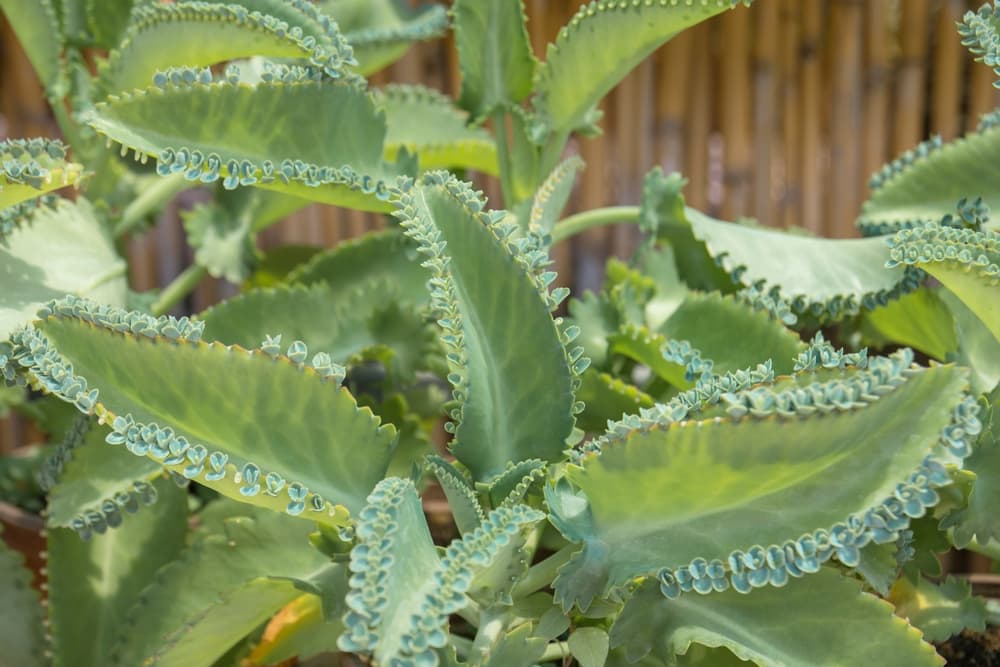
A number of different plants within the Kalanchoe genus are commonly cultivated as houseplants, or used in succulent or rock gardens in warmer climes.
They are popular for their drought tolerance and ability to survive in low-water conditions.
They are typically popular houseplants because of their attractive and interesting flowers and foliage, and because they are pretty easy to care for and grow.
Kalanchoe Varieties
If you are interested in growing Kalanchoe, you might be wondering which species and variety to choose.
Here are some of the popular options that you might like to consider:
K. blossfeldiana

This is the Kalanchoe plant most commonly grown as a houseplant.
It is sometimes called ‘Flaming Katy’, or ‘Panda Plant’.
This species has large flower heads that come in a range of hues.
Naturally, these Kalanchoe will bloom in the spring, though they can be forced to flower at any time throughout the year.
K. porphyrocalyx
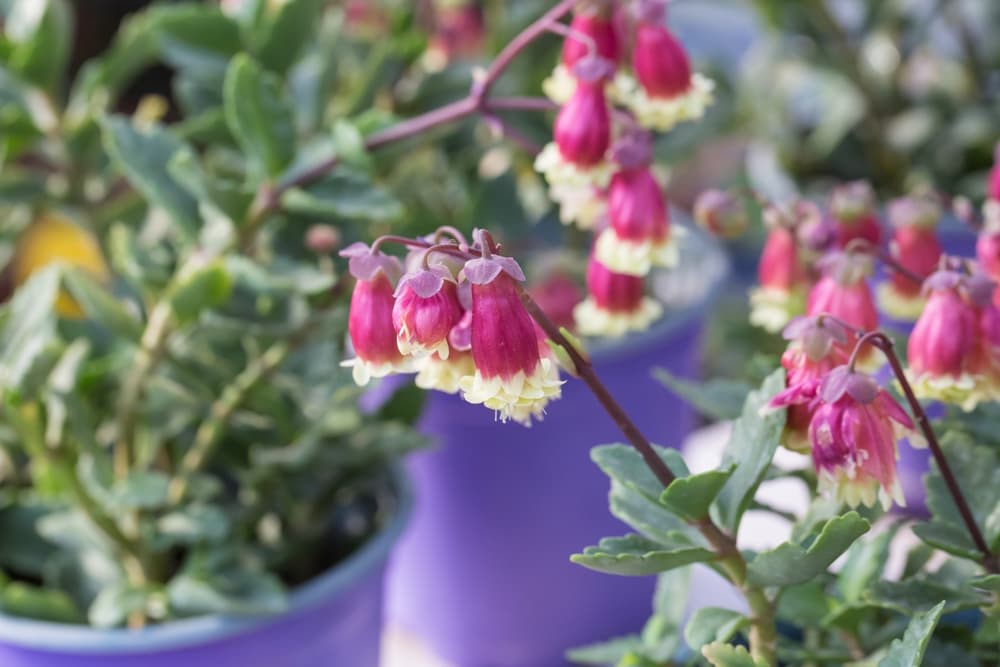
The pretty purple, pendant flowers on this type of Kalanchoe give it its popular name ‘Pearl Bells’.
This is another attractive variety that looks rather delicate with its bell flowers and slender leaves.
K. manginii

This species also has bell-shaped flowers, though somewhat larger ones – it also has fleshy leaves.
While most Kalanchoes are relatively unfussy when it comes to humidity levels, this one needs moist air to flower successfully.
K. pinnata

K. pinnata has fleshy green leaves and forms tiny plantlets around the edges of the parent plant.
K. beharensis
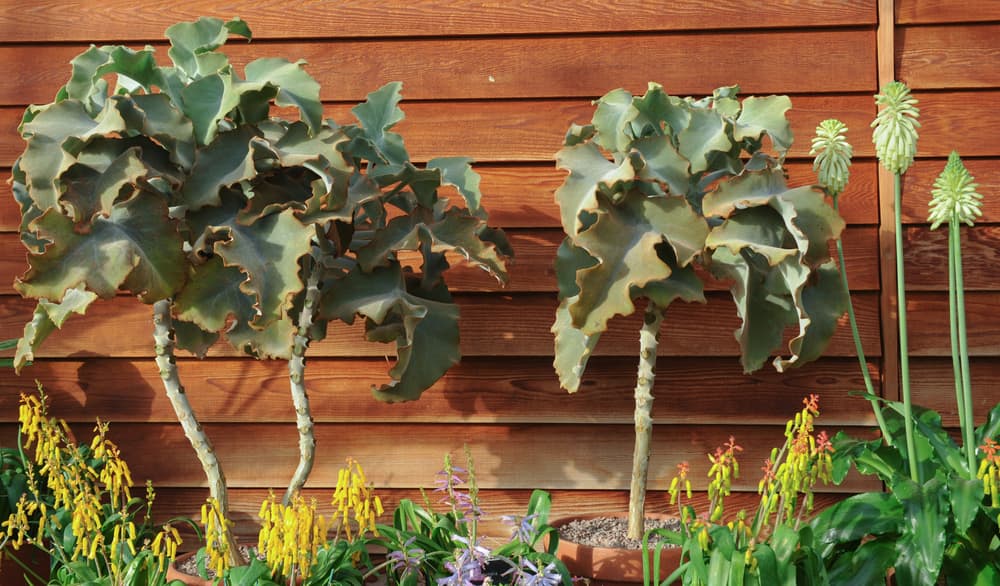
The best thing about this species is its large, lush and velvety leaves that shimmer a soft silvery green.
Where To Grow Kalanchoe
Kalanchoe can be grown outdoors in USDA planting zones 10-12 (RHS Hardiness Zones H1B – H3).
Temperature & Sunlight
Since the UK lies within USDA Zones 6-9, this means that it is not usually possible, except in the most dramatically mild of gardens, to grow these plants outdoors.

These plants need plenty of sunlight and warmth, so it is best to position them in a room which is light and bright.
However, it is best to avoid placing them on south-facing window sills or in direct sunlight.
When in direct sunlight, the leaves can scorch, and the plant may not bloom.
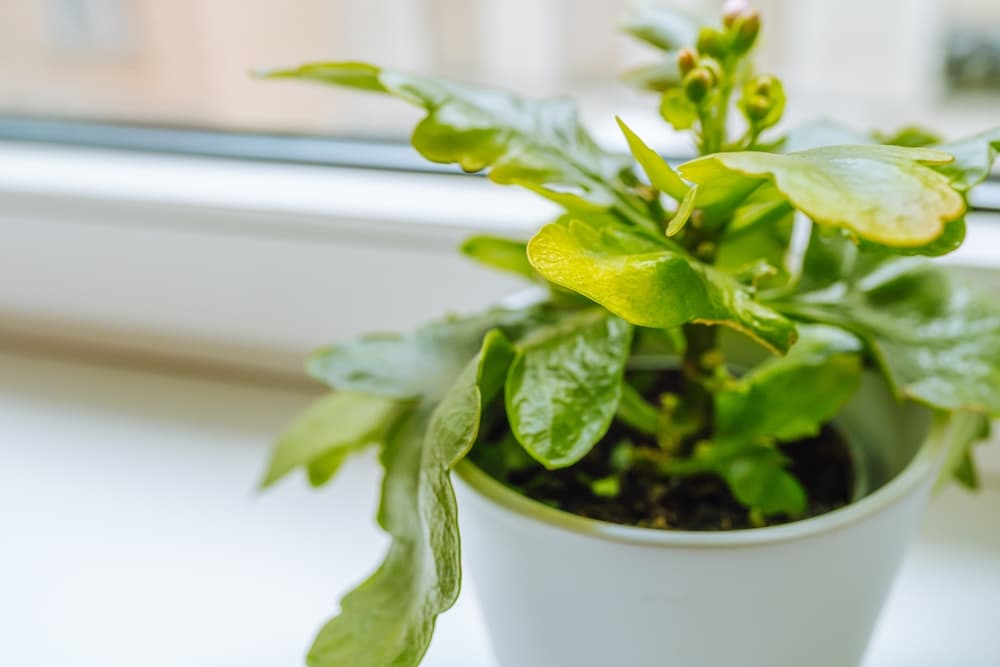
The good news is that when it comes to temperature and humidity, Kalanchoe plants are not too fussy.
As long as the temperature fluctuations within the room in which it is placed are not too extreme, these plants will thrive at a range of temperatures between around 12-27°C.
Soil Requirements
As a succulent, kalanchoe needs a growing medium that does not contain too much moisture.
It is also important to choose a pot or container that will wick excess water away more easily.

A clay pot filled with 50% potting soil and 50% grit will be suitable; make sure there is good drainage at the base of the pot.
In terms of the size of the container, what is required will depend on the size of the specimen, but mature single plants are usually grown in pots around 17-18cm in diameter.
Alternatively, two or three plants can be clustered together and grown in one pot of around 21-22 inches in diameter.
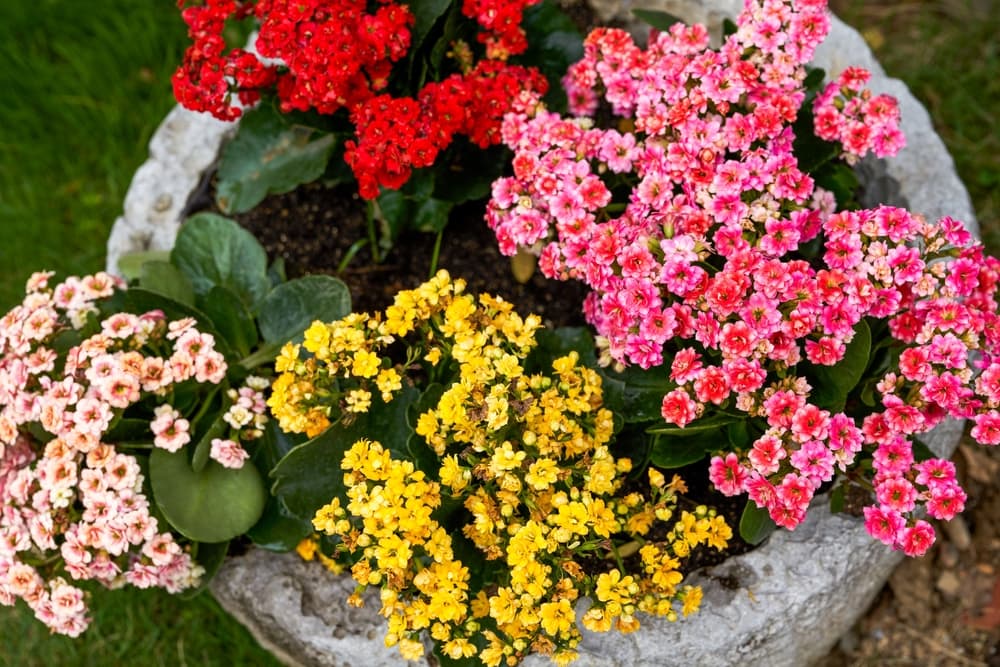
Do not choose a pot overly large for your plant, as this could make problems with waterlogging and excess moisture more likely.
Kalanchoe Succulent Care
Kalanchoe, like many other succulents, are plants that you can ‘kill with kindness’.
The biggest mistake you can make is watering them too much.
These are plants that can, to a certain extent, thrive on neglect – so if you are someone who is not that good about remembering to water your houseplants, this could be a good choice for you.
These plants should only be watered well every few weeks or so over most of the year – and even less over the winter months.

Between waterings, you should let the plant dry out entirely.
To check to see whether you need to water, stick your finger into the growing medium – if there is any moisture there at all, hold off a few more days before watering.
To prevent problems such as root rot, watering too little is always better than watering too much.
Remember, like other succulents, Kalanchoe stores water in its leaves to see it through a drought.
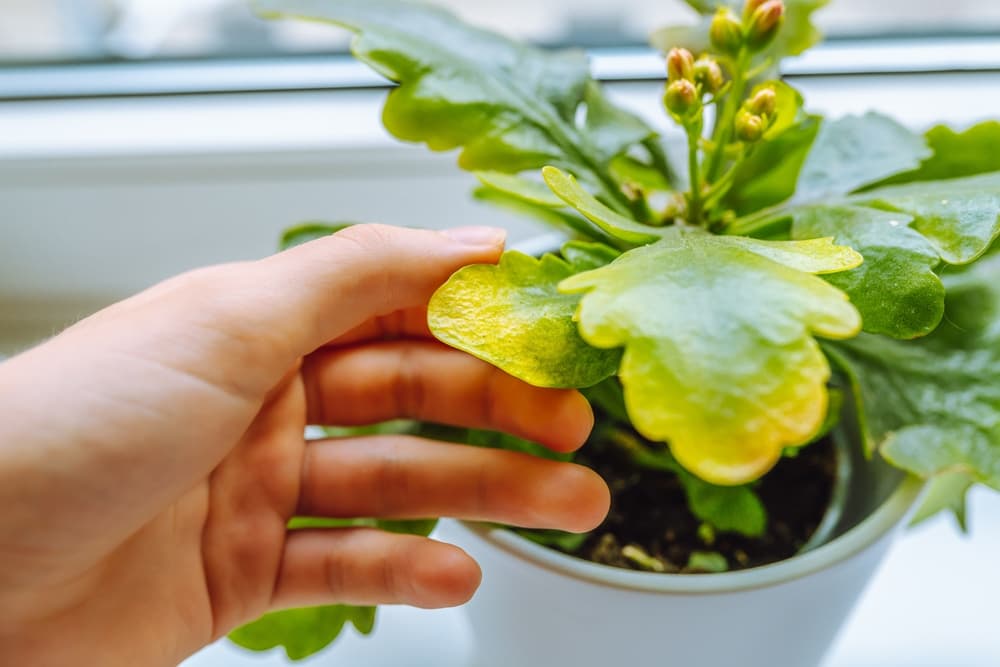
The only other care that will be required for best results is fertilisation.
You should only ever use an organic plant feed, and never overdo fertilisation – especially when it comes to nitrogen.
Like other flowering plants, a fertiliser that is rich in potassium will help boost blooms.
Apply a fertiliser with balanced NPK (nitrogen, phosphorus, potassium) a couple of times over the growing season.
How To Get Kalanchoe To Flower
Some people have issues when trying to get their Kalanchoe to bloom again once the initial flowers have faded.
Kalanchoes are photoperiodic. In other words, they bloom in reaction to light and require dark periods to flower repeatedly.4Currey, C., & Erwin, J. (2011). Photoperiodic Flower Induction of Several Kalanchoe Species and Ornamental Characteristics of the Flowering Species. Hortscience, 46(1), 35–39. https://doi.org/10.21273/hortsci.46.1.35
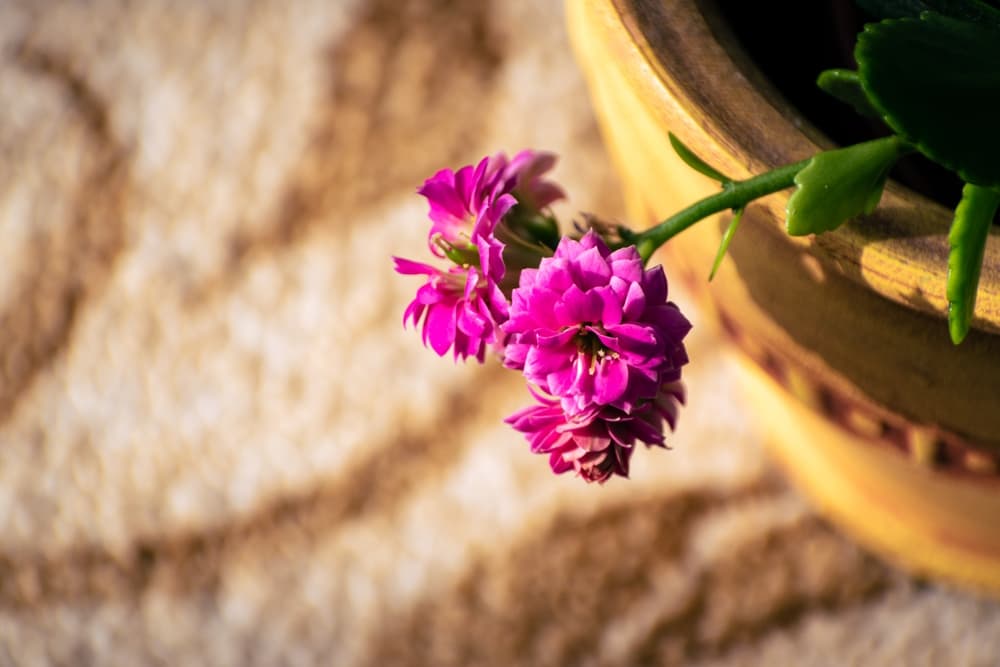
It may be that they have not received the requisite amount of darkness.
Make sure they get 12-14 hours of darkness every night for a couple of months over the winter and they should bloom again the following spring.
If you want to ‘force’ your kalanchoe – in other words – get it to bloom for a specific time such as Christmas, for example, you need to ‘trick’ the plant into thinking that it has come through winter and into spring.
Minimise watering and make sure the plant has 14 hours of darkness and 10 hours of light each day for a minimum of 6 weeks before the desired bloom time (to send it into dormancy).

As soon as you see flower buds, you should move the plant back to a brighter spot and start watering as usual.
Remove the spent flowers to make sure the plant does not put energy into sustaining spent blooms, and to encourage new buds to form.
In the right conditions, and usually without much effort on your part, having Kalanchoe plants in your home should allow you to enjoy bright blooms for up to 6 months of the year.
Propagating Kalanchoe
One of the reasons that succulents like Kalanchoe are so popular to grow is that, once you have one, it is incredibly easy to propagate your plant and increase your houseplant stock.
If you know someone who has a Kalanchoe plant that you admire, you might even be able to ‘steal’ a little stem segment to propagate a new plant from it for yourself.

All you have to do is take a stem segment from a mature plant, let it ‘cure’ or dry out for a few days, then place it into a pot with a suitable growing medium.
Hold off watering and it should root within around 4 weeks or so.5Davenport, M. (2007, April 20). Kalanchoe. Home & Garden Information Center. Retrieved March 20, 2023, from https://hgic.clemson.edu/factsheet/kalanchoe/
With some varieties, you can simply remove and plant the plantlets that form around the parent plant.
References
- 1Rhodiola (Rhodiola rosea L.). (n.d.). Science Direct. https://doi.org/10.1016/b978-0-12-812491-8.00052-7
- 2Kalanchoe. (n.d.). Plants of the World Online. Retrieved June 27, 2023, from https://powo.science.kew.org/taxon/urn:lsid:ipni.org:names:30060186-2#children
- 3Trinklein, D. (2017, January 5). Kalanchoe: The Versatile Houseplant. Integrated Pest Management: University of Missouri. Retrieved March 20, 2023, from https://ipm.missouri.edu/MEG/2017/1/Kalanchoe/
- 4Currey, C., & Erwin, J. (2011). Photoperiodic Flower Induction of Several Kalanchoe Species and Ornamental Characteristics of the Flowering Species. Hortscience, 46(1), 35–39. https://doi.org/10.21273/hortsci.46.1.35
- 5Davenport, M. (2007, April 20). Kalanchoe. Home & Garden Information Center. Retrieved March 20, 2023, from https://hgic.clemson.edu/factsheet/kalanchoe/

